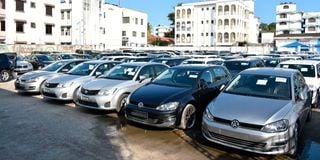Premium
Dealers and buyers feel painful pinch as cars get too expensive

Second-hand motor vehicles at Eyre Motors yard in Mombasa on July 5, 2021.
A sharp rise in car prices has thrown dealers and buyers into panic. Dealers are contending with poor sales as prospective buyers kept away due to high prices.
The increase in vehicle prices has seen demand plunge amid a tough economic environment for both individuals and businesses.
Prices of used cars have for example jumped by about 55 per cent in the past year--keeping buyers away.
Motor dealers earn a commission on sales, but official statistics indicate that the motor vehicle industry is facing thin sales.
Data from the Kenya National Bureau of Statistics (KNBS) shows that 49,751 new and used units were registered in the period between January and August last year, a 17 per cent drop from the 60,006 vehicles that were registered in the same period in 2021.
The statistics show that registration of saloon cars and station wagons dropped 26 per cent and 22 per cent to 3,781 and 31,833 units respectively in the review period compared to 2021.
Another set of statistics from the Kenya Motor Vehicle Industry Association (KMI), which covered the entire year shows that sales of new luxury cars fell 15.4 percent in the year that ended December 2022 as increased prices drove customers away.
It shows that the formal dealers sold a total of 104 units in 2022 down from the 123 units they dealt a year earlier.
Sales in the entire new vehicle market meanwhile declined by a smaller margin of 6.3 per cent to 5,968 units, according to the data.
Kenya Auto Bazaar Association Secretary-General Charles Munyori told Smart Business that the supply of vehicles is constrained leading to a dearth in the market.
Mr Munyori said the increase in car prices is primarily caused by lower production by vehicle manufacturers in the main source markets which has heated competition for available units.
He said carmakers have ditched mass production and are now making them on demand, which has reduced the number of vehicles available for sale.
“Due to Covid-19 pandemic we saw manufacturers in China, Japan, and other key markets downscale their operations thereby stopping mass-producing vehicles,” said Mr Munyori.
Mr Munyori said franchisees of vehicle brands now make orders for delivery of vehicles for sale for a period of typically one year then the manufacturers embark on producing the vehicles.
“What this has done is that there are fewer vehicles on the market and because competition for the available ones is high the prices go up,” he said.
Reduced sales also come at a time the government – which is a major customer – continued its vehicle leasing programme in a bid to reduce the fiscal burden of buying vehicles outright.
The National Treasury has so far leased 6,800 vehicles through the programme in six phases and is seeking to lease another 1,410 vehicles for four years.
This has hit sellers of new cars with government units and agencies such as the National Police Service (NPS), counties, and parastatals among the major buyers of brand-new motor vehicles.
US lender JPMorgan attributes the increase in global car prices to global supply chain issues, especially a biting chip shortage that is holding up production in the auto industry, creating a supply crunch.
The firm said elevated raw material costs are also driving car prices up, exacerbated by the Russia-Ukraine crisis.
“We estimate that half of the increase in new vehicle prices relates to the passing along of higher input costs, including raw material costs,” said Ryan Brinkman, lead automotive equity research analyst at JPMorgan.
Prices of used cars have also gone up attributed to fewer people disposing of their vehicles in source markets such as the UK, Germany, Japan, and China owing to the high prices of new cars.
This comes at a time the Kenyan shilling has continued to drop sharply over the past year pushing up the cost of imports.
At the beginning of January last year, the shilling was trading at 113.1 units against the US dollar but slumped to 125 units on Friday, a depreciation of 10.5 per cent.
Vehicles from Japan dominate the Kenyan second-hand segment with a market share of more than 80 per cent.
Japanese vehicles are preferred by buyers who say their spare parts are easier to obtain locally than those of other brands.
“Those who wanted to sell their cars are no longer selling because at the moment prices to buy a new car are high,” said Mr Munyori.
The shortage of used cars is also being felt in other markets such as the UK where the average price of a used Fiat Panda has risen by 18.7 per cent compared to a year ago.
The price of a Toyota Avensis has also gone up by 17.9 per cent.





